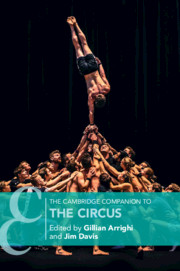Book contents
- The Cambridge Companion to the Circus
- Cambridge Companions to Theatre and Performance
- The Cambridge Companion to the Circus
- Copyright page
- Contents
- Figures
- Contributors
- Acknowledgements
- Timeline
- Introduction
- Part I Transnational Geographies of the Modern Circus
- Chapter 1 The Origins and Growth of the Modern Circus
- Chapter 2 Reconstruction, Railroads, and Race
- Chapter 3 Circus, Colonialism, and Empire
- Chapter 4 The Criollo Circus (Circus Theatre) in Argentina
- Chapter 5 The Past and Present of Czech Circus
- Chapter 6 Catching On
- Part II Circus Acts and Aesthetics
- Part III Circus
- Part IV Circus Studies Scholarship
- Bibliography
- Index
- References
Chapter 3 - Circus, Colonialism, and Empire
The Circus in Australasia and Asia
from Part I - Transnational Geographies of the Modern Circus
Published online by Cambridge University Press: 22 June 2021
- The Cambridge Companion to the Circus
- Cambridge Companions to Theatre and Performance
- The Cambridge Companion to the Circus
- Copyright page
- Contents
- Figures
- Contributors
- Acknowledgements
- Timeline
- Introduction
- Part I Transnational Geographies of the Modern Circus
- Chapter 1 The Origins and Growth of the Modern Circus
- Chapter 2 Reconstruction, Railroads, and Race
- Chapter 3 Circus, Colonialism, and Empire
- Chapter 4 The Criollo Circus (Circus Theatre) in Argentina
- Chapter 5 The Past and Present of Czech Circus
- Chapter 6 Catching On
- Part II Circus Acts and Aesthetics
- Part III Circus
- Part IV Circus Studies Scholarship
- Bibliography
- Index
- References
Summary
Following the establishment of the modern circus in London and Paris during the later decades of the eighteenth century, the circus began its steady dispersion around the world. The global transmission of this new sort of public entertainment by peripatetic performers and entrepreneurs was in no small measure attributable to waves of colonialism, industrial advances in transportation and communication, and motivations arising from commercial interests. This chapter charts the transference of the circus to Australasia (Australia and New Zealand), the territories of Southeast Asia (including present-day Malaysia, Singapore, Indonesia, and the Philippines), and the South Asian territories of the Indian subcontinent and China in the nineteenth century. What is little understood about the processes of circus transculturation in these regions is that circus companies originating from colonial territories undertook transnational touring projects, thus enacting aesthetic and transcultural movements between territories on the periphery of empire. This chapter brings to light the ways that circuses were agents of colonialism and empire, as well as transcultural transmitters of aesthetic innovation in the period that was both the Age of Empire and the Age of Modernity.
- Type
- Chapter
- Information
- The Cambridge Companion to the Circus , pp. 48 - 62Publisher: Cambridge University PressPrint publication year: 2021

